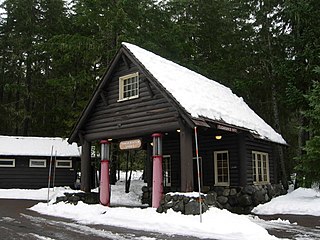
Longmire, which is effectively encompassed by the Longmire Historic District, is a visitor services center in Washington State's Mount Rainier National Park, located 6.5 miles (10.5 km) east of the Nisqually Entrance. The area is in the Nisqually River valley at an elevation of 2,761 feet (842 m) between The Ramparts Ridge and the Tatoosh Range. Longmire is surrounded by old-growth douglas fir, western red cedar and western hemlock.
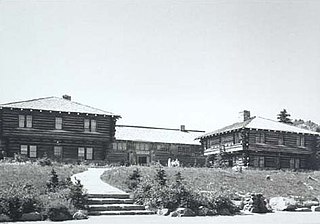
The Yakima Park Stockade Group, also known as North and South Blockhouses, Museum, and Stockade at Sunrise, is a building complex consisting of four log buildings at the Sunrise Visitors Center area in the northeast part of Mount Rainier National Park. The complex is architecturally significant as a particularly fine example of rustic frontier log architecture. The first of the blockhouses and the stockade were built in 1930, while the second blockhouse followed in 1943. It was declared a National Historic Landmark in 1987. It is in turn part of the Mount Rainier National Historic Landmark District, which encompasses the entire park and which recognizes the park's inventory of Park Service-designed rustic architecture.

The Sunrise Comfort Station (S-310) is a comfort station in Mount Rainier National Park, Washington, USA. Built around 1930, the building was designed by Thomas Chalmers Vint of the National Park Service in association with landscape architect E.A. Davidson. The structure was part of a planned ensemble at what was then called Yakima Park, high on the northern flank of Mount Rainier. Similar structures may be found at the Ohanapecosh, Longmire and White River campgrounds in the park. The low building is framed in peeled logs on a stone foundation, set into a hillside and surrounded by native landscaping.
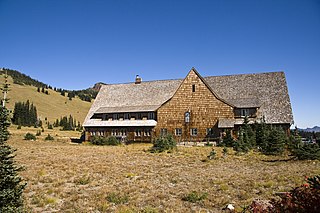
The Sunrise Historic District, also known as the community of Sunrise, Washington, is located at approximately 6,400 feet (2,000 m) on a ridge overlooking the northeast side of Mount Rainier in Mount Rainier National Park. The district comprises seven individual structures designed in accordance with the principles of the National Park Service Rustic style. The area is inhabited and open to the public only during a brief period in the summer season.

The White River Entrance to Mount Rainier National Park is a complex of buildings built between 1929 and 1931 to accommodate visitors arriving on the Yakima Park Highway, in the northeastern portion of the park. Like most of the structures in Mount Rainier, the buildings are designed in the National Park Service Rustic style, using natural stone and log materials. The historic district includes the 1933 Men's Mess Hall and Dormitory, believed to be the only surviving camp structure built by the Civilian Conservation Corps in the park.

The White River Mess Hall and Dormitory is the only remaining Civilian Conservation Corps camp structure remaining in Mount Rainier National Park. The wood-framed building was built in 1933, and comprising 2,185 square feet (203.0 m2), originally containing a kitchen dining room, living room, two bathrooms, a bedroom and a bunkroom, as well as a service porch. The building no longer serves as a residence and is used for storage. It is located at the White River entrance to the park, part of a complex of service buildings.

The Christine Falls Bridge is a reinforced concrete arch bridge in Mount Rainier National Park, spanning Van Trump Creek at Christine Falls. The bridge was built in 1927–1928 by contractor J.D. Tobin of Portland, Oregon, who built the Narada Falls Bridge at the same time. The arch has a three-centered profile and spans 56 feet (17 m). The bridge is 30 feet (9.1 m) wide. It was faced with rubble stonework and is an example of National Park Service Rustic design.

The Wonderland Trail is an approximately 93 mile (150 km) hiking trail that circumnavigates Mount Rainier in Mount Rainier National Park, Washington, United States. The trail goes over many ridges of Mount Rainier for a cumulative 22,000 feet (6,700 m) of elevation gain. The trail was built in 1915.

The Gobbler's Knob Fire Lookout is a fire lookout tower in the extreme western region of Mount Rainier National Park at an elevation of 5,485 feet (1,672 m). One of four fire lookouts remaining in the park, the lookout is used for visitor services during summer weekends. The building is about 14 feet (4.3 m) by 14 feet (4.3 m), and was designed by the National Park Service Branch of Plans and designs under the supervision of Acting Chief Architect Edwin A. Nickel. It was built in 1933. The two-story structure features a balconied lookout on the second level, with storage on the ground level. Cables secured to deadmen keep the lookout from blowing over. The lookout was extensively damaged in a 2006 storm. It has since been repaired.

The Huckleberry Creek Patrol Cabin is located in the northern portion of Mount Rainier National Park, Washington, United States. It was built around 1934 to house rangers on patrol within the park. The log cabin's design resembles the "Standard Plan for Patrol Cabins" prepared by the Western Division of the National Park Service, with the addition of a full-width front porch. Civilian Conservation Corps labor may have been used in the construction of the cabin.

Indian Henry's Patrol Cabin is an early National Park Service patrol cabin in Mount Rainier National Park. The cabin was built in 1915–1916 at an elevation of 5,300 feet (1,600 m) in an area of the park known as "Indian Henry's Hunting Ground," which had been used in the 19th century by the Cowlitz and Nisqually tribes. "Indian Henry" was an Indian guide who accompanied James Longmire in his explorations of the area. The Indian Henry's area became a tourist destination with the 1908 establishment of the "Wigwam Camp," a tent camp which was abandoned in 1918. The area remained as a headquarters for backcountry patrols; the cabin was the first such facility in the park.
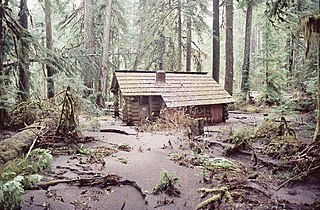
The Ipsut Creek Patrol Cabin was built by the United States National Park Service in 1933 in Mount Rainier National Park to house backcountry rangers. The log cabin resembles other cabins at Huckleberry Creek, Lake James and Three Lakes, all built to standard plans from the Park Service Branch of Plans and Designs, supervised by Acting Chief Architect W.G. Carnes. The cabin is approximately 24 feet (7.3 m) by 14 feet (4.3 m), with a lean-to storage shed to the rear.

The Lake George Patrol Cabin was built in 1934 by the National Park Service in Mount Rainier National Park as a backcountry patrol station and hiker's shelter. The single-story wood-frame building measures about 26.5 feet (8.1 m) by 12 feet (3.7 m). Initially intended as a horse barn, it was converted for ranger accommodation, replacing a 1921 structure. The first cabin survived until 1969, when it was destroyed by a falling tree.

The White River Bridge was built in 1929 in Mount Rainier National Park as part of the Yakima Park Road project. The new road was planned to open up access to the northeastern portion of the park. The bridge, spanning the White River, was built by contractor John D. Tobin of Portland, Oregon, who had previously built the Narada Falls Bridge and the Christine Falls Bridges, both listed on the National Register of Historic Places. Plans for the bridge were drawn by the National Park Service Branch of Plans and Designs in the National Park Service Rustic style, with construction supervision by NPS landscape architect Ernest A. Davidson. The three-centered arch spans 60 feet (18 m), with a stone-faced concrete structure.

The Tolmie Peak Fire Lookout is one of four fire lookout stations built in Mount Rainier National Park by the United States National Park Service (NPS) between 1932 and 1934. The two-story structure houses a lookout station on the upper level and storage at ground level. The design was prepared under the supervision of Edwin A. Nickel of the NPS Branch of Plans and Designs. The newly completed structure lost its roof to a windstorm and had to be repaired. It is secured against strong winds by cables attached to deadmen. The wood frame structure is used as a visitor contact point on weekends.
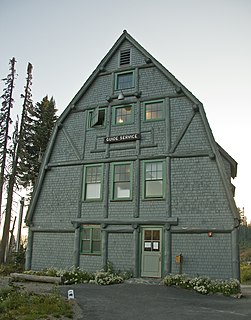
The Paradise Historic District comprises the historic portion of Paradise developed area of Mount Rainier National Park. The subalpine district surrounds its primary structure, the Paradise Inn, a rustic-style hotel built in 1917 to accommodate visitors to the park. The Paradise Inn is a National Historic Landmark. Five other buildings are included in the district. The district was placed on the National Register of Historic Places on March 13, 1991. It is part of the Mount Rainier National Historic Landmark District, which encompasses the entire park and which recognizes the park's inventory of Park Service-designed rustic architecture.

The St. Andrews Patrol Cabin was built by the National Park Service in 1922 as part of a network of stations near the boundaries of Mount Rainier National Park for rangers on patrol. The one-room log structure stands on the Wonderland Trail that circumnavigates Mount Rainier. The exterior of the cabin features a porch to the front. The interior is finished with varnished logs and tongue and groove flooring. The cabin was placed on the National Register of Historic Places on March 13, 1991. It is part of the Mount Rainier National Historic Landmark District, which encompasses the entire park and which recognizes the park's inventory of Park Service-designed rustic architecture.

The Mount Fremont Fire Lookout is a fire lookout in the northern region of Mount Rainier National Park at an elevation above 7,000 feet (2,100 m), the highest in the park. One of four fire lookouts remaining in the park, the lookout is used for visitor services during summer weekends. The building is about 14 by 14 feet, and was designed by the National Park Service Branch of Plans and designs under the supervision of Acting Chief Architect Edwin A. Nickel. It was built in 1933. The two-story structure features a balconied lookout on the second level, with storage on the ground level. Cables secured to deadmen keep the lookout from blowing over. The Park Service was assisted during construction by the Emergency Conservation Works Association.

The Nisqually Entrance Historic District comprises the first public entrance to Mount Rainier National Park. The district incorporates the log entrance arch typical of all Mount Rainier entrances, a log frame ranger station and checking station, a comfort station and miscellaneous service structures, all built around 1926, as well as the 1915 Superintendent's Residence and the 1908 Oscar Brown Cabin, the oldest remaining structure in the park. The buildings in the district conform to the principles of the National Park Service Rustic style that prevailed in park design of the 1920s and 1930s.

The St. Andrews Creek Bridge was built in 1930-31 as part of the West Side Road in Mount Rainier National Park.



















